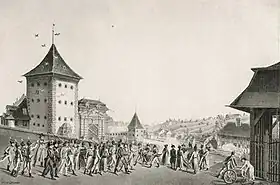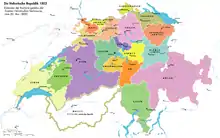| Stecklikrieg | |||||||
|---|---|---|---|---|---|---|---|
 The death of Lieutenant Rudolf von Werdt during the siege of Bern on 18 September 1802, an episode of the Stecklikrieg. Drawing by Karl Ludwig Zehender, 1805. | |||||||
| |||||||
| Belligerents | |||||||
|
|
Federalists | ||||||
| Commanders and leaders | |||||||
| Johann Rudolf Dolder |
Alois von Reding Niklaus Franz von Bachmann | ||||||
The Stecklikrieg ("War of Sticks") was a civil war in Switzerland in 1802 that resulted in the collapse of the Helvetic Republic, the renewed French occupation of Switzerland and ultimately the Act of Mediation dictated by Napoleon Bonaparte on 19 February 1803. The conflict itself was between insurgents, mostly drawn from the rural population, and the official forces of the Helvetic Republic. The term Stäckli, or "wooden club," from which the conflict draws its name, refers to the improvised weaponry of the insurgents.
Background

Following the Treaty of Lunéville of 1801, French troops suddenly left Switzerland in late July 1802, resulting in rapid destabilization of the country.[1] This instability reached a head in August, with an open rebellion of Swiss federalists against the unitary Helvetic Republic.[1] The revolt originated in Central Switzerland and was centered around the cities of Zürich and Bern, the canton of Baden, as well as rural parts of the Swiss plateau in the cantons Aargau and Solothurn.[1] It would eventually spread to most of the Republic's nineteen cantons.[2]
Course of the war
The war began with an engagement at Rengg Pass on 28 August, where government troops were defeated by federalists from Nidwalden, followed by unsuccessful artillery attacks on Zürich from 10 to 13 September by government forces.[1] The rebels soon captured Bern, which was also briefly shelled.[1] The Helvetic government, headed by Landamman Johann Rudolf Dolder, capitulated militarily on September 18, but was able to negotiate a retreat from Bern to Lausanne before collapsing entirely.[1][3]
With the exception of Léman and Fribourg, executive power was restored to the cantonal governments and a Federal Diet in Schwyz led by Alois von Reding.[1] On 30 September, First Consul Napoleon Bonaparte issued the proclamation of Saint-Cloud, calling for a return to constitutional order and inviting both parties to a conciliatory conference in Paris, known as the "Helvetic Consulta".[2] Niklaus Franz von Bachmann, commander-in-chief of the federal army, inflicted a final defeat on the Helvetic army at Faoug on 3 October.[1] Bonaparte then launched a military intervention under General Michel Ney to pacify the country, disarm the federalists and restore the Helvetic Republic.[4] Under French pressure, the Federal Diet at Schwyz announced its dissolution on 26 October, bringing an end to the Stecklikrieg.[4]
With the more liberal order of the Helvetic Republic, anti-Jewish sentiment rose, as accusations emerged that Jews were unfairly profiting from the unpopular new order. On the 21st of September 1802, the hatred and resentment came to a head in the so-called “Zwetschgenkrieg” or plum war. In an outbreak of violence, spurred on by antisemitic rumours, an armed horde of 800 farmers, craftsmen and some patricians assaulted the Surbtal Jews, looting and destroying their homes and belongings. The attack was not entirely unexpected, tensions having built up over several days, and the Christian inhabitants of Endingen and Lengnau were largely unaffected. The Jews did not receive compensation for the damages, and the perpetrators did not face any consequences.[5][6]
Aftermath
Napoleon was concerned that the instability of Switzerland could infect Europe at large, and was authorized to negotiate a settlement between the feuding sides.[7] His Act of Mediation made concessions to the demands of the insurgents, abandoning the centralist structure of the Helvetic Republic in favor of a more federalist approach. He likewise stated the natural state of Switzerland was federal and that attempts to force any other system upon them were unwise.[8]
The British response
French intervention constituted a breach of the Treaty of Amiens, which was used as a pretext by the United Kingdom to resume their war against France on 18 May 1803. The French involvement within the internal affairs of the Swiss was exemplary of Britain's worry that it was to have a diminishing role in continental affairs. Though the British often attempted to stay removed from the internal struggles of the Continent, the actions of Napoleon's France threatened to upset the existing order and thus Britain's existing economic supremacy.[9] While the Act of Mediation enforced by French intervention did not particularly upset the Swiss order, in fact restoring much of pre-existing traditions and forms of Swiss government from before the French Republican invasion, it was a technical violation of the Treaty of Amiens, which prohibited such foreign meddling by France.[10]
In regards to civil response to the actions of the French, William Wordsworth's poem Thought of a Briton on the Subjugation of Switzerland was directly inspired by the events of the Stecklikrieg. His poetry of the period was his response to the "easy jingoism" which he considered to often captivate the British populace. In the Subjugation of Switzerland, he relates his experiences on the differences between the "place" of a nation and the "politics" of one. He saw the French intervention in Switzerland as a repudiation of the philosophy of the Revolution and supported the British declaration of the continuation of the war against France, though he did still sympathize with the values initially claimed by the French Revolution.[11]
See also
References
- 1 2 3 4 5 6 7 8 Jürg Stüssi-Lauterburg: Stecklikrieg in German, French and Italian in the online Historical Dictionary of Switzerland, 2012-02-20.
- 1 2 Helvetic Republic in German, French and Italian in the online Historical Dictionary of Switzerland.
- ↑ Switzerland, Markus G. Jud, Lucerne. "History – All About Switzerland". swiss-government-politics.all-about-switzerland.info. Retrieved 12 December 2016.
{{cite web}}: CS1 maint: multiple names: authors list (link) - 1 2 Victor Monnier: Michel Ney in German, French and Italian in the online Historical Dictionary of Switzerland.
- ↑ "Zwetschgenkrieg gegen die Juden". 15 August 2017.
- ↑ Bergmann, Werner (2020). Tumulte ― Excesse ― Pogrome: Kollektive Gewalt gegen Juden in Europa 1789-1900 (in German). Wallstein. p. 134. ISBN 978-3-8353-3645-2.
- ↑ Federal Diet in German, French and Italian in the online Historical Dictionary of Switzerland.
- ↑ PM, Andreas Fankhauser /. "Médiation". HLS-DHS-DSS.CH (in French). Retrieved 12 December 2016.
- ↑ Englund, Steven (2008). "xxMONSTRE SACRÉ: THE QUESTION OF CULTURAL IMPERIALISM AND THE NAPOLEONIC EMPIRE". The Historical Journal. 51 (1): 215–250. doi:10.1017/S0018246X07006656. S2CID 162263868.
- ↑ "Treaty of Amiens | France [1802]". Encyclopædia Britannica. Retrieved 12 December 2016.
- ↑ Behrendt, Stephen (1995). "Placing the places in Wordsworth's 1802 sonnets". SEL: Studies in English Literature 1500–1900. 35 (4) – via ProQuest.